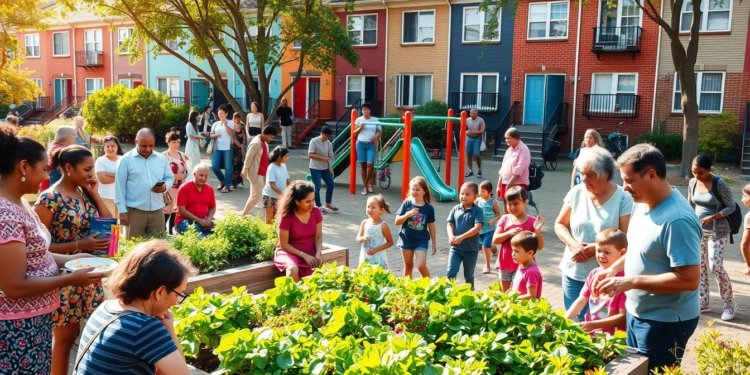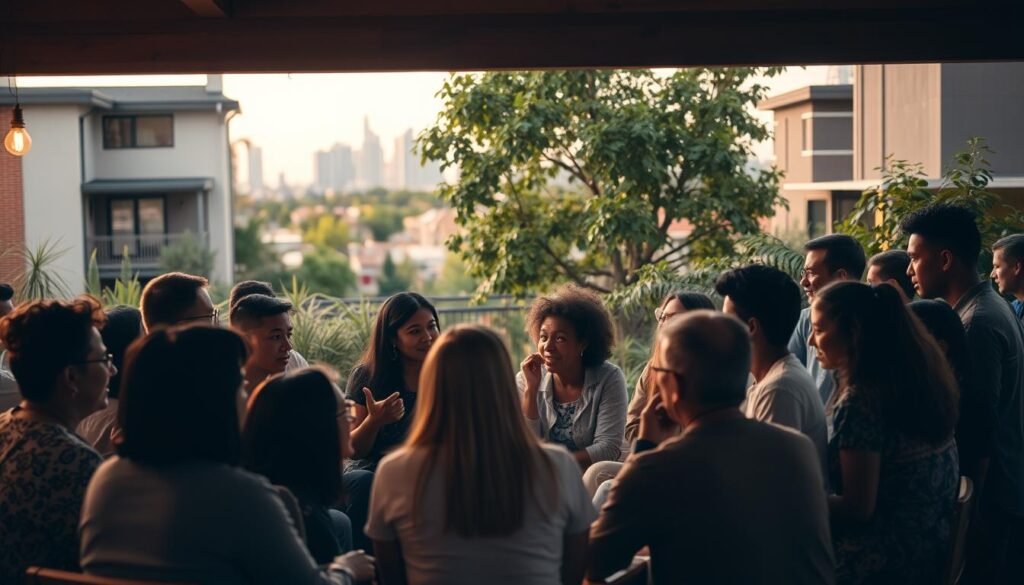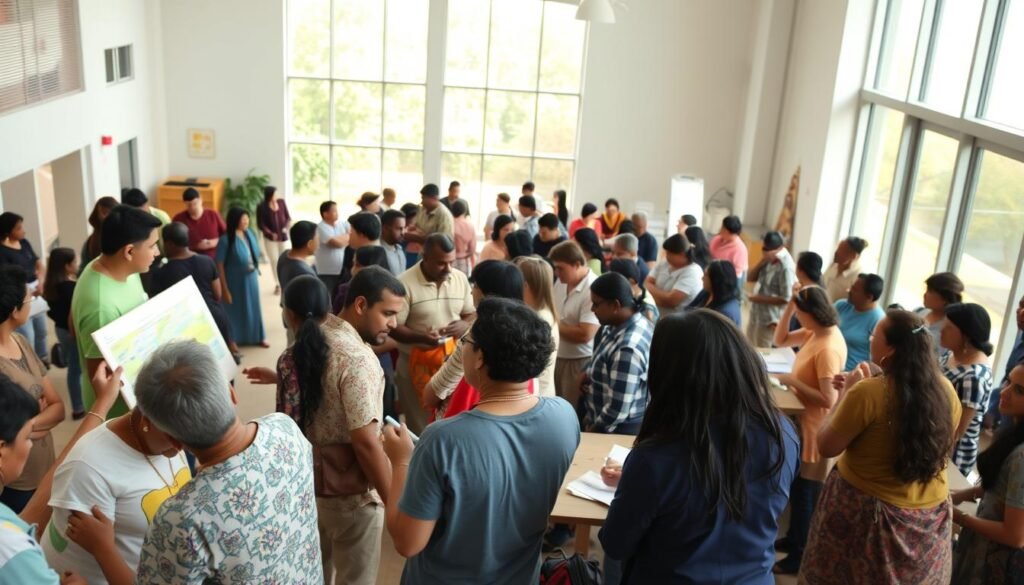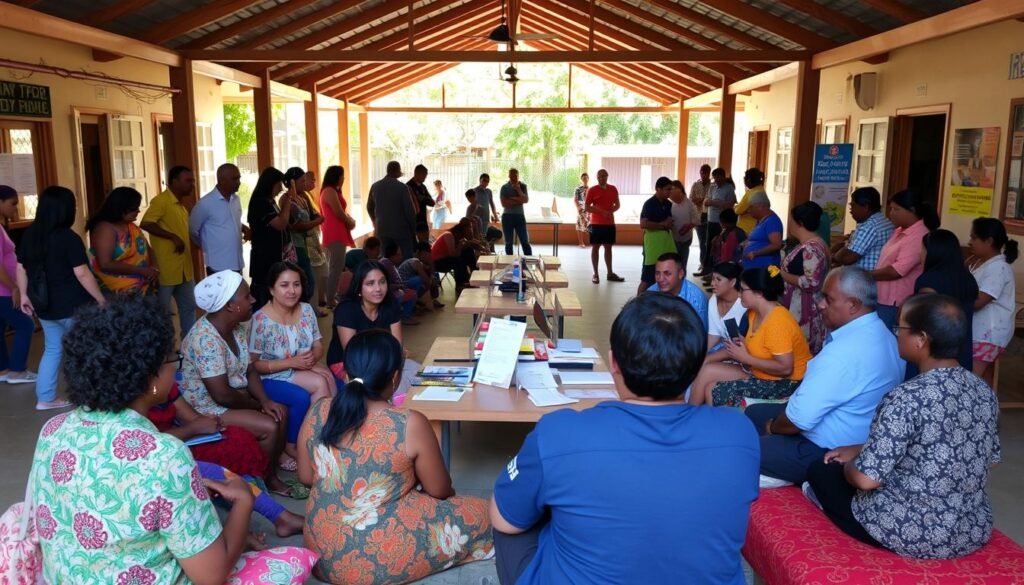What if the key to thriving neighborhoods lies in breaking old barriers? Rising housing costs and post-pandemic challenges have reshaped how we think about local growth. Traditional models often left gaps, but new approaches are proving more effective.
From ARPA-funded projects to worker-led efforts, cities are testing fresh strategies. Case studies from LISC highlight how economic fairness and resident-led planning create lasting change. The shift isn’t just about policy—it’s about people.
Key Takeaways
- Post-pandemic vacancies and housing costs demand new solutions.
- Inclusive models outperform outdated exclusionary practices.
- Federal funding like ARPA supports innovative local projects.
- Worker organizing has shown measurable success in revitalization.
- Resident input ensures plans reflect real needs.
Understanding Inclusive Community Development
Neighborhoods thrive when everyone has a seat at the table. Research by Chavis, Lee, and Buchanan outlines four pillars: equal access, shared power, mutual respect, and targeted investment. These principles turn fractured areas into cohesive ones.
Defining an Inclusive Community
Albuquerque’s Project Change shows how anti-racism policies work. Local banks reformed lending to support minority-owned businesses. This boosted economic participation by 40% post-COVID.
In contrast, West Oakland lost 71% of its Black residents from 1950-1970 due to highway projects and redlining. Without deliberate inclusion, groups get pushed out.
Why Inclusion Matters for Neighborhoods
Everett, WA’s Casino Road park upgrades prove trust speeds progress. Leaders spent months listening to immigrant families before designing play spaces. The result? Higher usage and fewer vandalism reports.
Clarksburg, WV rebuilt after a 2020 cross-burning by prioritizing dialogue. Resident-led task forces now guide city resources toward equity programs.
When people shape their neighborhood, solutions last. Exclusion costs more than inclusion ever could.
Key Principles of Inclusive Community Development
Strong neighborhoods grow when every voice shapes their future. These efforts thrive on fairness, respect, and intentional steps to uplift all residents. From Albuquerque to Oakland, proven models show how these principles work.
Respect and Equal Access
Albuquerque’s asset exchange program lets small businesses trade services instead of cash. This removes financial barriers for minority-owned shops. Equal access to tools and training boosted success rates by 35%.
- Funding for language interpreters at meetings
- Flexible scheduling for working families
- Transparent decision-making processes
- Cultural competency training for staff
- Data tracking to measure gaps
Valuing Diversity and Representation
Everett’s light rail project preserved 82% of immigrant-run businesses by offering rent subsidies. Charlotte’s $1M fund helps Black entrepreneurs secure storefronts in gentrifying areas. These strategies turn diversity into strength.
Oakland’s EB PREC cooperative lets residents own commercial spaces collectively. One bakery tripled its revenue after joining. When groups control assets, they create lasting opportunities.
Strategies for Engaging Underrepresented Groups
Barriers fade when outreach meets people where they are. More in Common’s research reveals “disappointed but pragmatic” residents often disengage when their needs feel ignored. Bridging this gap requires intentional steps.
Identifying Barriers to Participation
Language gaps and digital divides silence many. In Everett, 25 immigrant-owned businesses surged after receiving translation services. Oakland’s monthly infrastructure reviews now include Spanish and Vietnamese summaries.
Digital exclusion remains a hurdle. Libraries in Charlotte loan tablets and offer travel reimbursements for meetings. These small fixes boost participation by 40% in low-income groups.
Tailoring Outreach to Marginalized Communities
Casino Road’s success started with listening. Fifty-two entrepreneurs completed business training after classes aligned with work schedules. Charlotte’s COVID grants funded 79 minority-owned shops by simplifying applications.
Community engagement thrives when systems adapt. Trust grows when actions match words.
Building Trust in Diverse Neighborhoods
Trust transforms neighborhoods faster than any policy ever could. When residents see actions match promises, engagement soars. From Everett’s parks to Oakland’s jazz clubs, small wins pave the way for big change.
Moving at the Speed of Trust
LISC Puget Sound’s park upgrades took months of listening first. Leaders hosted barbecues instead of town halls. This relaxed approach doubled attendance from working families.
Top-down plans often fail. Clarksburg’s reconciliation task force proved dialogue works better than decrees. After a hate incident, weekly coffee chats rebuilt fractured community ties.
Early Wins and Relationship-Building
- Everett’s carnival drew 300+ immigrant families to plan a playground. Surveys showed 89% felt heard.
- Oakland saved Esther’s Orbit Room by funding repairs. The jazz landmark now trains local youth.
- Charlotte’s 1,700+ businesses got coaching on leases and permits. Minority-owned shops grew by 22%.
Quick results matter. When residents see progress, trust deepens. Clarksburg’s mural project, finished in six weeks, became a symbol of unity.
Case Studies: Successful Inclusive Development
Real-world examples show how cities are rewriting the rules of urban growth. From Everett to Charlotte, grassroots efforts prove that strategies centered on equity deliver lasting results. These initiatives combine data, partnerships, and cultural insights to reshape neighborhoods.
Everett, WA: Preserving Immigrant Businesses
When light rail construction threatened 25 immigrant-owned shops, Everett acted. The city offered rent subsidies and language-accessible training. Today, 82% of those businesses remain open, boosting the local community’s economic diversity.
A $790,000 grant program provided emergency relief during COVID-19. Small shops adapted with outdoor seating and delivery apps. This nimble response kept cultural hubs like family-run bakeries alive.
Oakland, CA: Revitalizing 7th Street
Nine redevelopment projects transformed Oakland’s historic jazz district. The EB PREC cooperative let residents own commercial spaces collectively. One music venue, Esther’s Orbit Room, now trains youth in audio engineering.
Before revival, 7th Street faced steep decline. Today, it’s a model for blending heritage with innovation. The community’s input ensured designs honored the area’s legacy.
Charlotte, NC: Empowering the Historic West End
Fifth Third Bank’s Black Futures Program invested $1 million here. Grants helped Black entrepreneurs secure leases in gentrifying areas. Over 1,700 businesses received coaching on permits and finances.
Residents led the planning process, prioritizing affordable housing and green spaces. Their vision turned vacant lots into thriving community gardens. This approach reduced displacement risks by 22%.
Community-Led Planning and Decision-Making
True progress begins when residents shape their own streets and spaces. Traditional top-down planning often misses local nuances, but cities like Oakland and Charlotte prove that collaborative strategies yield better results. The COMPAS inclusion framework highlights how shared power strengthens every phase of urban work.
Shifting from Top-Down to Collaborative Approaches
Oakland’s Black Economics Salons flipped the script. Instead of officials dictating policies, Black business members co-designed anti-displacement programs. Monthly forums led to microloans for 30 shops—a 45% survival rate boost during economic downturns.
Everett’s business needs assessment template became a national model. By sharing customizable surveys with other cities, they standardized community engagement while respecting local contexts. Small businesses reported 28% faster permit approvals after adopting the tool.
Tools for Equitable Engagement
Charlotte’s partnership with HBCUs brought student consultants into planning sessions. Their fresh perspectives helped redesign a transit hub, reducing walk times for 15,000 daily riders. The “nothing about us without us” philosophy ensured marginalized groups weren’t just a part of the process—they led it.
Hybrid engagement blends digital and in-person touchpoints. Detroit’s ARPA-funded app let residents vote on park designs, while Clarksburg’s block parties gathered elders’ oral histories. When tools meet people where they are, participation becomes second nature.
Addressing Systemic Inequities in Development
Systemic barriers don’t disappear by accident—they require deliberate dismantling. Local governments are using policy tools and grassroots partnerships to rewrite outdated rules. The $350B ARPA fund has accelerated this shift, with 22% of allocations targeting equitable recovery projects.
Policy Levers for Inclusion
Oakland’s anti-speculation ordinance shows how policy can protect vulnerable groups. The city buys properties before investors flip them, preserving 300+ affordable units since 2018. Charlotte’s commercial rent stabilization program pairs zoning changes with legal resources, reducing displacement by 18% in historic districts.
Everett trained 140 immigrant business owners in advocacy through its “Voice for All” program. Graduates successfully pushed for multilingual permit applications. Inclusionary zoning policies in 15 states now mandate affordable units in new developments, proving strategies scale when backed by data.
Anti-Displacement Strategies
Community benefits agreements (CBAs) are rewriting development rules. A Los Angeles CBA required 40% local hiring for a $1B project, creating 2,300 jobs. Detroit’s “Right to Remain” initiative funds home repairs to prevent tax-based displacement, stabilizing 1,100 households.
Small business incubators also combat displacement. Oakland’s pop-up market program gives vendors 12 months of subsidized space to test concepts. Six out of ten participants secure permanent locations—a model now replicated in three states.
Resources for Inclusive Community Development
Strong neighborhoods need more than good intentions—they need the right tools. Federal programs and private partnerships now offer concrete support to turn equity plans into reality. From microloans to cooperative models, these resources help bridge gaps that policies alone can’t address.
Funding and Technical Assistance
LISC’s three-city initiative channels $12M annually through local organizations. Oakland’s EB PREC model lets 40+ residents collectively own commercial spaces, with financing structures that cap investor returns at 5%. HUD’s Section 108 loans now prioritize projects with 30% minority contractor participation.
Technical assistance delivers measurable impact. Detroit’s small business incubators show a 3:1 ROI—every dollar spent on coaching generates $3 in new revenue. The Ford Foundation’s grant toolkit helps groups navigate 15+ federal funding streams.
Partnering with Local Governments
Local government collaboration unlocks larger opportunities. Charlotte’s “Open for Business” portal simplifies permit processes for 1,200+ entrepreneurs. In Albuquerque, the government matches private grants dollar-for-dollar for neighborhood projects.
Everett’s ARPA dashboard tracks $8M in equitable recovery spending. Their transparent reporting builds trust while ensuring funds reach underserved areas. These partnerships prove systemic change happens when civic and grassroots efforts align.
Measuring Outcomes and Impact
Impact measurement separates hopeful plans from proven results. Cities like Everett and Charlotte now track both numbers and narratives to assess progress. This dual approach reveals what strategies create lasting change.
Quantitative and Qualitative Metrics
Casino Road’s engagement benchmarks show 72% resident participation after five years—up from 31%. Surveys revealed why: childcare support and translated materials removed barriers. Hard data meets human experience.
West End’s business survival rates jumped 22% post-intervention. Owner interviews highlighted coaching on leases as the game-changer. Oakland’s 7th Street now has 89% occupancy, with youth employment doubling at revived jazz venues.
Long-Term Sustainability
Clarksburg’s hate incidents dropped 67% after reconciliation work. Their intergenerational assessment model tracks both crime stats and schoolyard interactions. Lasting change requires measuring across time.
Detroit’s ARPA dashboard shows 83% of funds reached minority-led projects. Five-year goals now include resident-developed success metrics. When numbers and stories align, neighborhoods thrive.
Conclusion
Stronger neighborhoods emerge when residents lead the way. Everett, Oakland, and Charlotte prove that strategies valuing local expertise create lasting change. Their models share key traits: fair compensation for resident input, adaptive reuse of existing spaces, and policy reforms that prioritize equity.
Economic benefits multiply when cities repurpose vacant buildings for small businesses. This approach preserves cultural identity while boosting local economies. Institutional changes—like simplified permits and anti-displacement funds—ensure progress reaches those who need it most.
The work doesn’t stop at planning. Measuring outcomes and adapting strategies ensures intergenerational fairness. Every neighborhood deserves solutions shaped by its people.
FAQ
What is inclusive community development?
It’s an approach that ensures all residents, especially underrepresented groups, have a voice in shaping their neighborhoods. This means valuing diversity, removing barriers, and fostering trust.
Why is inclusion important for local governments?
When cities engage all residents, policies better reflect collective needs. This leads to stronger neighborhoods, economic growth, and reduced inequities over time.
How can leaders engage marginalized groups effectively?
Tailored outreach—like multilingual meetings or culturally relevant events—helps. Building relationships and addressing specific concerns also increases participation.
What are some anti-displacement strategies?
Policies like rent control, affordable housing mandates, and small business grants protect long-term residents from being pushed out during revitalization.
How do you measure success in these efforts?
Track both numbers (e.g., housing affordability rates) and stories (resident feedback). Long-term impact is seen in sustained engagement and equitable outcomes.
Where can cities find funding for inclusive projects?
Federal grants (e.g., HUD), nonprofits like LISC, and public-private partnerships often support initiatives that prioritize equity and resident leadership.
What role do local governments play?
They set policies, allocate resources, and facilitate collaboration between residents, businesses, and organizations to ensure fair development.
How can residents get involved?
Attend planning meetings, join neighborhood associations, or advocate for policies that reflect their needs. Many cities also offer training for grassroots leaders.









